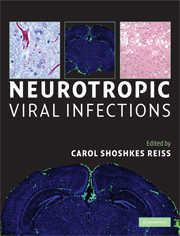Book contents
- Frontmatter
- Contents
- List of contributors
- Foreword
- Preface and acknowledgments
- Section I Introduction: RNA viruses
- Section II Introduction: retroviruses, DNA viruses, and prions
- 8 Human T-lymphotropic virus type 1 and disease in the central nervous system
- 9 HIV infection of the central nervous system
- 10 JC virus molecular biology and the human demyelinating disease, progressive multifocal leukoencephalopathy
- 11 The herpes simplex viruses
- 12 The pathogenesis of varicella-zoster virus neurotropism and infection
- 13 Transmissible spongiform encephalopathies
- Section III Introduction: immunity, diagnosis, vector, and beneficial uses of neurotropic viruses
- Index
- Plate section
- References
10 - JC virus molecular biology and the human demyelinating disease, progressive multifocal leukoencephalopathy
from Section II - Introduction: retroviruses, DNA viruses, and prions
Published online by Cambridge University Press: 22 August 2009
- Frontmatter
- Contents
- List of contributors
- Foreword
- Preface and acknowledgments
- Section I Introduction: RNA viruses
- Section II Introduction: retroviruses, DNA viruses, and prions
- 8 Human T-lymphotropic virus type 1 and disease in the central nervous system
- 9 HIV infection of the central nervous system
- 10 JC virus molecular biology and the human demyelinating disease, progressive multifocal leukoencephalopathy
- 11 The herpes simplex viruses
- 12 The pathogenesis of varicella-zoster virus neurotropism and infection
- 13 Transmissible spongiform encephalopathies
- Section III Introduction: immunity, diagnosis, vector, and beneficial uses of neurotropic viruses
- Index
- Plate section
- References
Summary
Introduction
JC virus (JCV) is a human neurotropic polyomavirus that causes the fatal demyelinating disease of the central nervous system (CNS) known as progressive multifocal leukoencephalopathy (PML). JCV has also been found in association with various tumors of the CNS and other tissues. This virus requires strong suppression of the immune system in order to thrive and is usually present in a latent state in immunocompetent individuals. With the emergence of AIDS in the 1980s, the incidence of PML surged. Recently, there has been renewed interest in JCV due to the occurrence of PML in patients receiving treatment with novel classes of immunosuppressive monoclonal antibody drugs such as natalizumab, which inhibits extravasation of T-lymphocytes, and rituximab, which targets mature B-lymphocytes. Here we review the molecular biology of JCV Section (1) and the pathophysiology of PML Section (2) with special emphasis on exciting aspects of current research into this increasingly important pathogen.
The molecular biology of JCV
Introduction to JC virus (JCV)
JCV is a small human DNA virus and contains a double-stranded covalently linked circular genome, 5130 base pairs in size. It is the causative agent of a demyelinating disease in the CNS known as progressive multifocal leukoencephalopathy (PML). It has an icosahedral capsid approximately 45 nm in diameter. Originally JCV was classified in the Papovaviridae family within the polyomavirus genus [1], but later the polyomaviruses were recognized as a viral family separate from the papovaviruses by the International Committee on the Taxonomy of Viruses.
- Type
- Chapter
- Information
- Neurotropic Viral Infections , pp. 190 - 211Publisher: Cambridge University PressPrint publication year: 2008
References
- 11
- Cited by

